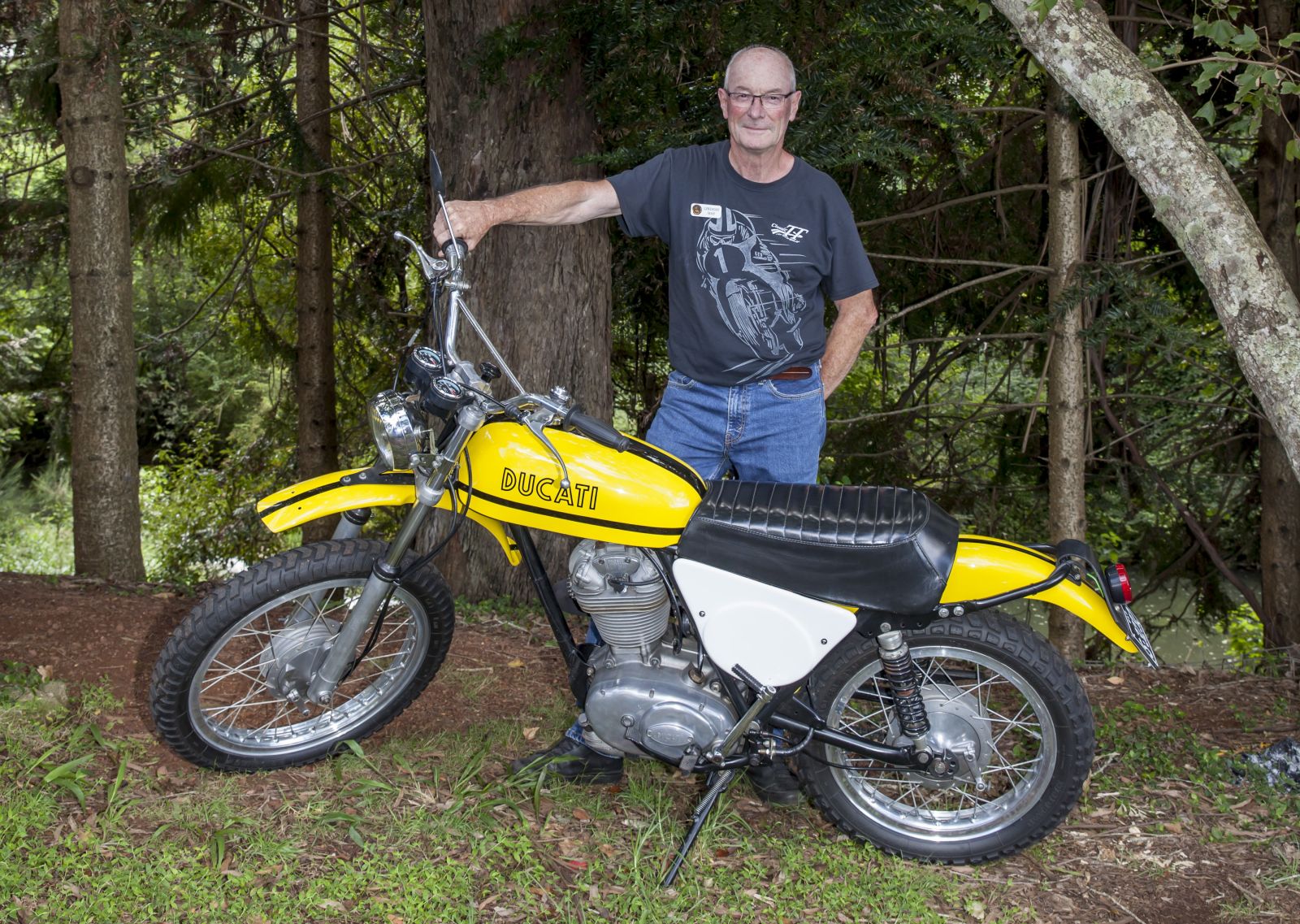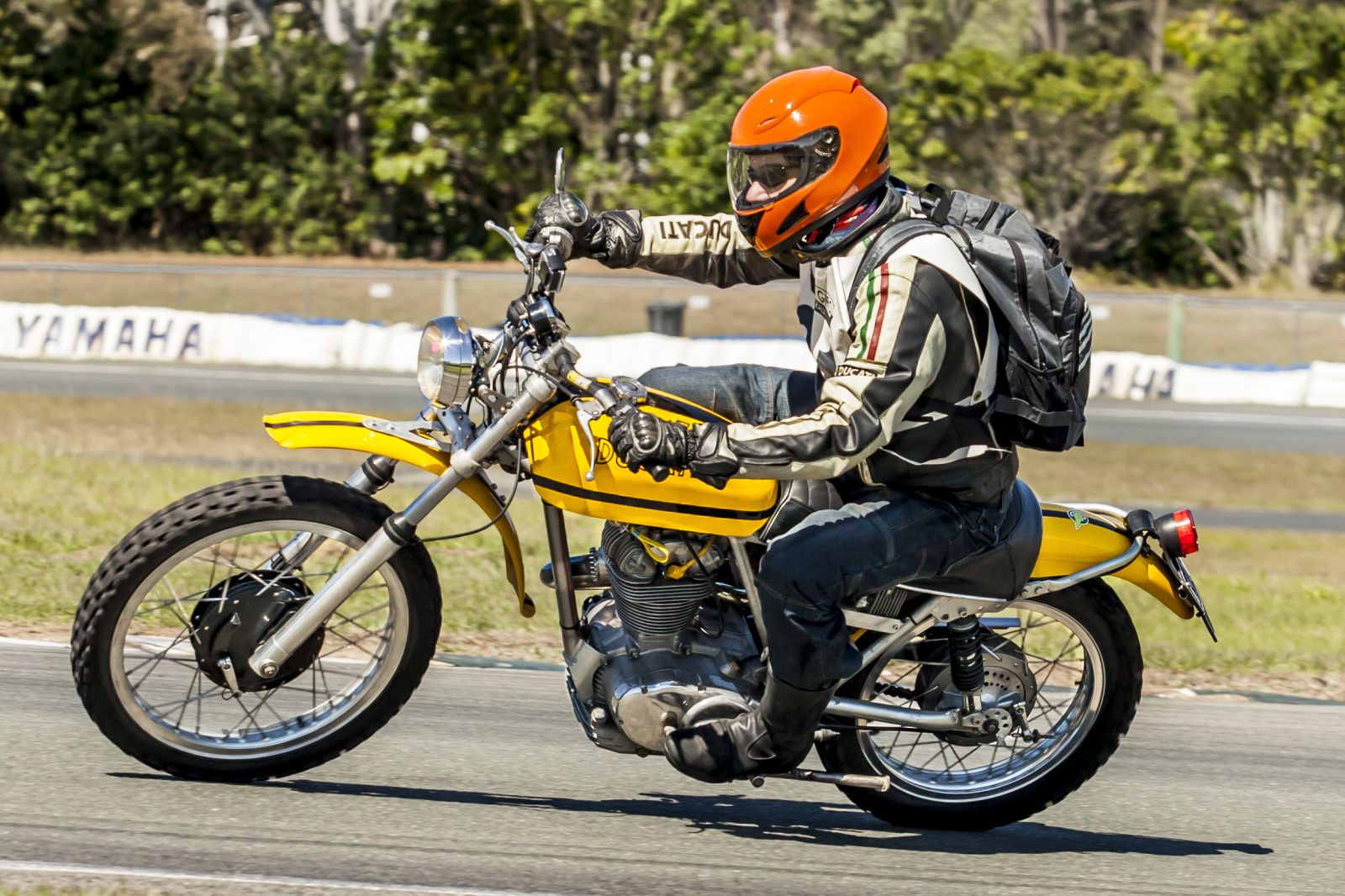Competition Ducati Off-Roaders
Author: Ellaspede (Gaven Dall’Osto) Date Posted:7 February 2025

IN THE BEGINNING
There are many theories as to the origins of scrambles/motocross. Records document that in the spring of 1924, the ‘Scott Trial’ was created by Scott Motorcycles founder (Alfred Scott) to get the workers together for a day out. They took factory motorcycles and rode the vacant landscape on the nearby Yorkshire moors. Subsequent modifications to suit these conditions gave Scott Motorcycles contracts to the War Department for despatch and machine gun outfits during WW1. The regular northern England ‘Scott Trial’ concept spread quickly. A southern England club (Camberley) challenged their northern brothers to see who were the best riders in the country. Acceptance was on the basis that one event was run in both regions. The Southerners had their own rules, which removed the observed component of ‘Trials Rules’ and, therefore, couldn’t be sanctioned by the ACU (Autocycle Union).
The name ‘scramble’ was coined, sanctioned and the ‘The Southern Scott Scramble’ was run on the 29th March 1924. This supposed first scramble event spread across the channel to France where they introduced shorter tracks and added obstacles and jumps, calling their version Motocross (MOTOcycle CROSScountry). By 1947 the FIM recognised the sport and the first international competition was held in Holland. In 1952 the FIM added a 500cc category and in 1957 it became a World Championship event.
SCRAMBLE / MOTOCROSS MOTORCYCLES
Post WW1 production road bikes were heavy and tough enough to be ridden to events once the ‘breakables’ were removed for Scrambles/Motocross racing. Competitive racers modified their machines to get any advantage and the factories followed as success guaranteed more sales. Rigid frames slowly gave way to fully sprung suspension, high level exhausts were optioned etc. In the UK, after WW2, BSA was the biggest motorcycle manufacturer in the world and their machines dominated international off-road competition. The introduction of a 250cc class in 1962 saw an influx of light and agile two strokes with new brands like Greeves, Husqvarna and CZ dominating. The English and European brands continued domination until the Japanese began their onslaught from the 1960’s.
DUCATI OFF-ROAD
The 1950’s saw Motocross flourish particularly in Northern Europe and Britain. Ducati (like most other motorcycle manufacturers) were involved in all forms of racing including off-road. In 1951, Ugo Tamarozzi won a bronze medal in the International Six Day Trial (ISDT) in Italy on a 65cc Cucciolo-powered Ducati prototype. It was the only machine in the under 75cc class to achieve an award. Ducati continued to enter their 48cc, 65cc and 98cc (push rod) models for a few more years before concentrating back on their forté, road racing.
By mid-1950 Ducati could not ignore the popularity nor the potential sales to be gained by off-road events. Motocross/scrambles, short track, long track, trials and even desert racing were very big in the UK, Europe and the US. The creation of the 250cc Italian off-road championship in 1956 may have been the final motivation. Tom Bailey, who was involved in the US market at the time, suggests that it was pressure from the US dealers (via Ducati importer Berliner Motor Corporation) as scrambles became more popular in the USA.
Interviews with Giorgio Monetti and Leopoldo Tartarini (famous for their 12-month Ducati world motorcycle tour) gave their account of the origins. Monetti’s story starts in early 1957 while working for Ducati where he, Taglioni, Antonelli, Borlotti and Stancari had seen the need to create a model to suit the rough minor Italian roads. They took the current 175, made the suspension softer, the handlebars and seat higher etc. for more off-road control and stability. Monetti reportedly rode this prototype for 7-8 months.
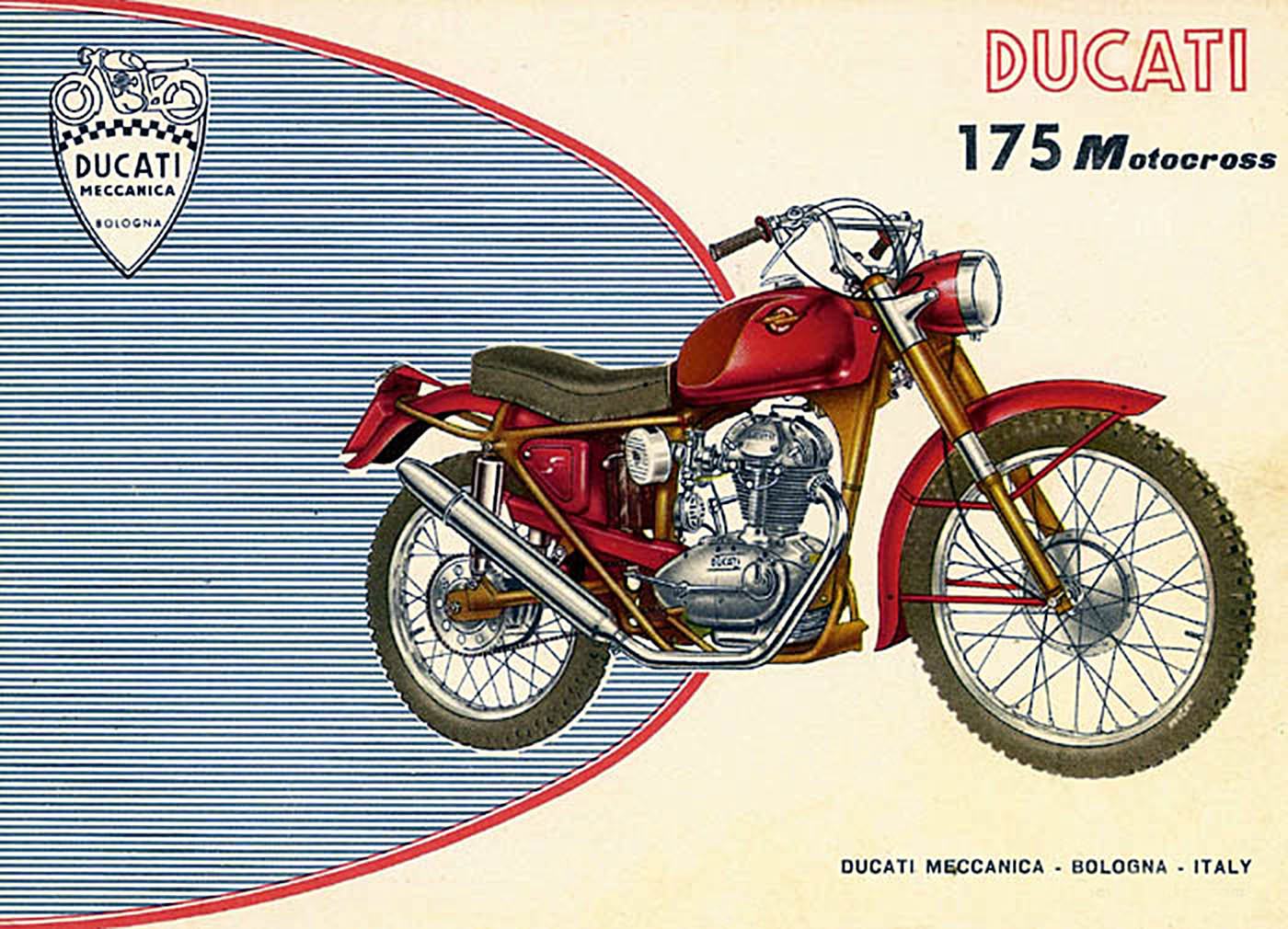
DUCATI MOTOCROSS IS BORN
Whatever the reason, the Ducati 175 Motocross was released in 1958. It was a serious attempt at targeting off-road competition. A 125cc variant was also listed; however, no examples of this version have surfaced. Some reports state that the Motocross was hand-made by the race department rather than the factory. The colours were inherited from the road models with a copper frame and candy apple red tinware. The engine gained an air-cleaner and upswept muffler but remained relatively standard. The rolling frame was updated with substantial gusseting, full sump protection, a completely new swingarm, a banana-shaped seat and longer Marzocchi front forks. The gusseted high-set handlebars, conical hubs and 19” rear and 21” reinforced front steel rims were also unique. A special peanut-shaped tank, lightweight substantially braced mudguards and knobby tyres completed the package. The 175 Motocross was joined by a 200cc version when the road bike version was released in 1959.
UK REJECTION
Mick Walker reported that only one 175cc Motocross was ever imported into the UK in 1959 for ex-road racer/then dealer, Alan Trow. The 200 Motocross was priced at £299 8S whereas a DOT 250 was £198 7S, BSA’s C15C Scrambler was £183 and even the BSA B34 Gold Star in Scrambler trim was only £282. With its high cost, the Motocross was really only an option for serious competition use.
US ADOPTION
Tom Bailey reported that the US market was happy to pay the high price. The 175 and 200 arrived mid-summer 1959 but again it was really a ‘competition only’ motorcycle. The son of the owner of the first Ducati dealership in Castle Rock, West Washington reported that his dad was a big fan. When he opened his shop, he immediately ordered three 200cc models. He nicknamed them ‘Big Frame Scramblers’ and was impressed by how, after a full day off-road riding, he couldn’t even find one oil leak. When Ducati released the 250cc engine he had one fitted in the Motocross frame as a special factory build which he kept for himself until 1993. While highly competitive against the best similar capacity machines like the Triumph 200 Cub, Tom Bailey quoted a few compromise points. One was the wet sump engine, which was taller than dry sump types and compromised ground clearance. He failed to acknowledge the advantages as there was no separate oil tank, no external oil lines prone to leak, a lower centre of gravity, cooler oil as the sump was in the air stream and the filler and drain plugs easier to get to.
MOTOCROSS UPGRADE
The 1960 200 Motocross engine was detuned with an upswept muffler replacing the racing megaphone and the front guard enlarged and moved closer to the tyre. In all, 15 to a maximum of 30 Ducati Motocrosses were thought to have been produced although Ian Falloon lists greater production figures.
GAP YEAR
Poor sales had the Motocross discontinued for 1961. The US dealers were furious at the loss of potential sales. They told Ducati they didn’t need a bulletproof Motocross but rather a light, nimble and fast machine for their smoother desert track market. The resultant 1962 ‘stripped back’ road bike - the Scrambler - was born and the subject of a different story.
WIDECASE DESMO
Jumping to late 1968 a bevel engine upgrade known as the ‘widecase’ was born. The road bike 250, 350 and new 450cc engines were now fitted with a desmodromic valve operating system which was utilised successfully in Ducati’s high revving road racing engines. In 1969, desert riders Doug Douglas and Jim McClurg won the motorcycle class at the first-ever Baja 500, riding a Ducati 350.
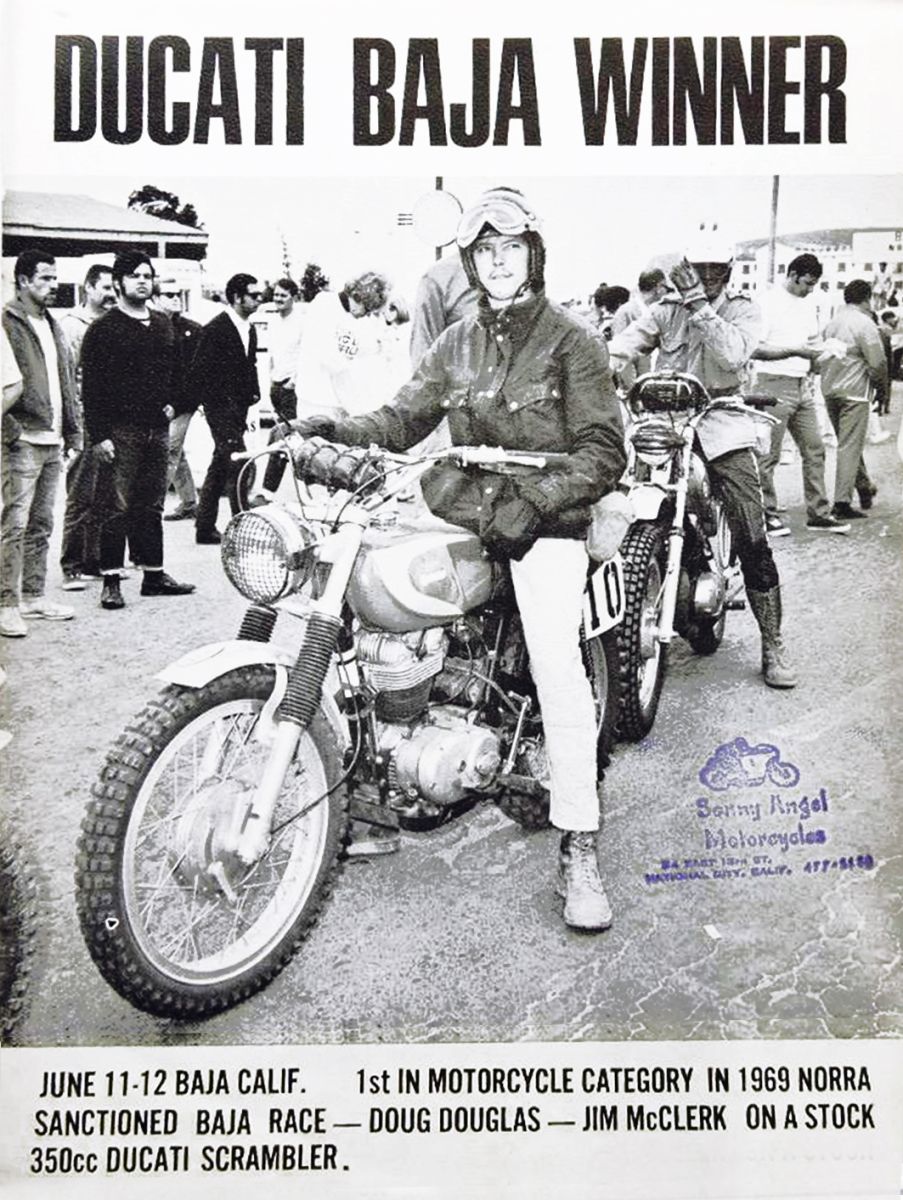
Sure, Ducati were producing 450 Scramblers but Berliner were inspired by the Baja win and decided that the 450 Desmo would make a successful challenger. In 1969 they started working on a prototype utilising a lightweight off-road frame, with outstanding handling made by Eric Cheney. It was completed in early 1970 and the prototype was shown to Ducati with significant pressure for another shot at a ‘serious’ competition machine. Ducati reacted and engaged a former Italian Scrambles champion Walter Reggiolli to assist in the development of what was to become the 350 and 450R/T (Road and Track) which was released at the end of 1970.
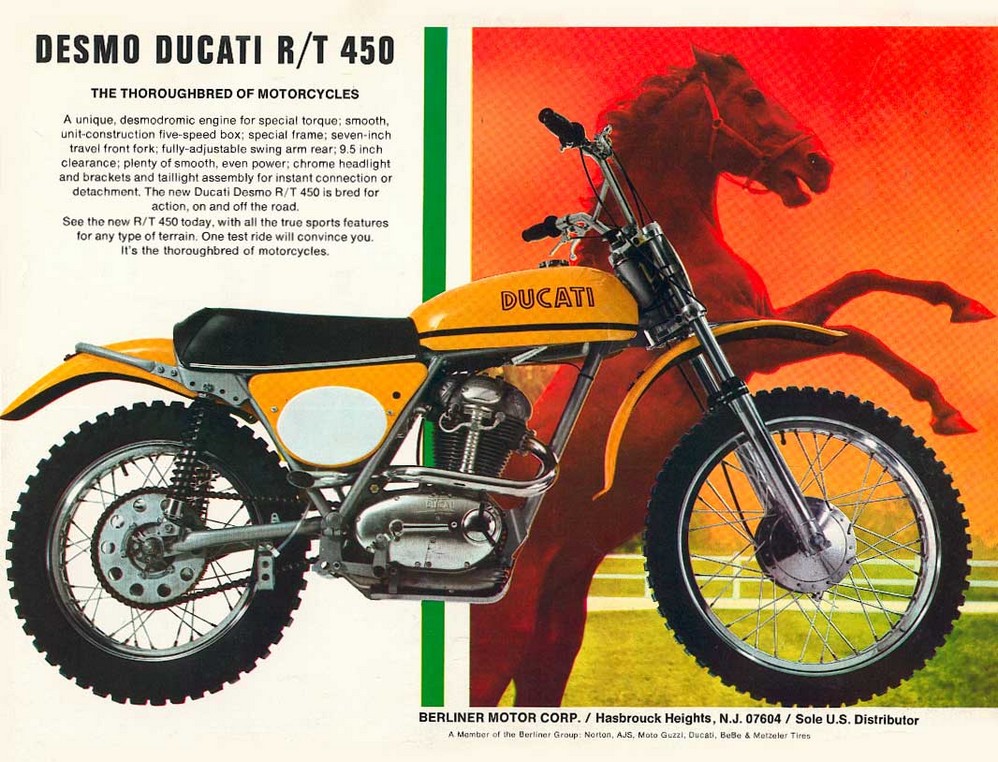
ROAD AND TRACK ATTACK
A small batch of R/T’s (called R/S in Italy) were released in 1971. The 350 had the standard engine and targeted the Italian market. The 450 was a Desmo and primarily targeted at the US. The 450R/T was fully off-road orientated with minimal electrics and didn’t even have an ignition switch. The R/T head was modified to include a decompression valve to aid starting which was difficult as it only had a side stand. The desmodromic system had the opening and closing rockers locked to the camshaft so a special valve was designed to penetrate the ignition chamber where it could vent to atmosphere. Its design mimicked a 10mm spark plug and positioned such that it could be swapped, creating a twin plug head for ultimate performance.
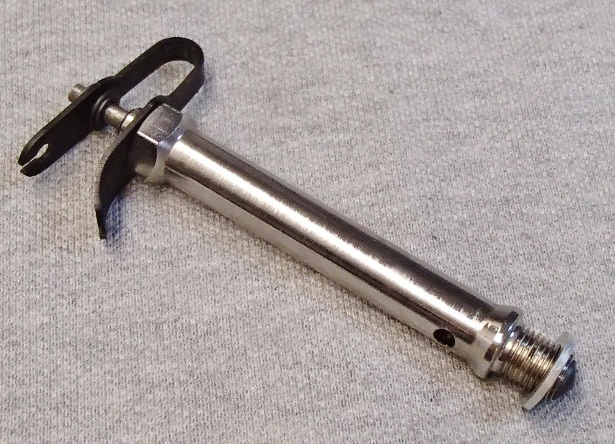
The external oil return line to the bevel shaft tower had to be re-routed around the decompression valve making this part unique to the Desmo R/T. The R/T (R/S) frame was also unique and touted as a Cheney/Metisse hybrid, also sharing some elements with the later 750GT. The rear upper damper mounts had four available positions from upright (providing the most forward weight bias) to angled forward (providing more leverage and softer action). The chain adjustment was by quick action rotating snail shell shaped cams. The normal central spine was complimented by two addition tubes welded to the head stock running parallel both sides and ending at the rear damper mounts. SKF taper roller bearings were fitted to the head stock instead of the normal loose ball items.
Two types of sprung loaded folding foot rests (without rubber grips) were supplied. One was a round steel rod multi-fit type, while the other had a serrated flat steel top and was handed left or right. The front Marzocchis were 35mm diameter and 600mm long with twin oil seals, no gaiters and achieving a full 7” (178mm) of travel. The rear Marzocchis were 320mm long, non-gaitered units. Wheels were lightweight alloy Borrani’s, 21” front and 18” rear. The front hub was a small light-weight Grimeca from the Monza Junior. The unbraced high-rise handlebars had quick-action Tomaselli throttle and cable adjusters.
The high-level exhaust weaved neatly in and out of the frame ending as an open pipe. There was no chain guard, only a lower chain guide was included. A plastic bottle with a valve and hose directed oil to constantly lubricate the chain. The fuel tank (now with screw-on cap), side-covers and guards were all lightweight fibreglass, unfortunately making them vulnerable to cracking. The side-covers included a white race number patch with a small hole in the right-side cover to allow easy adjustment of the carburettor. The colour scheme was yellow with a silver frame.
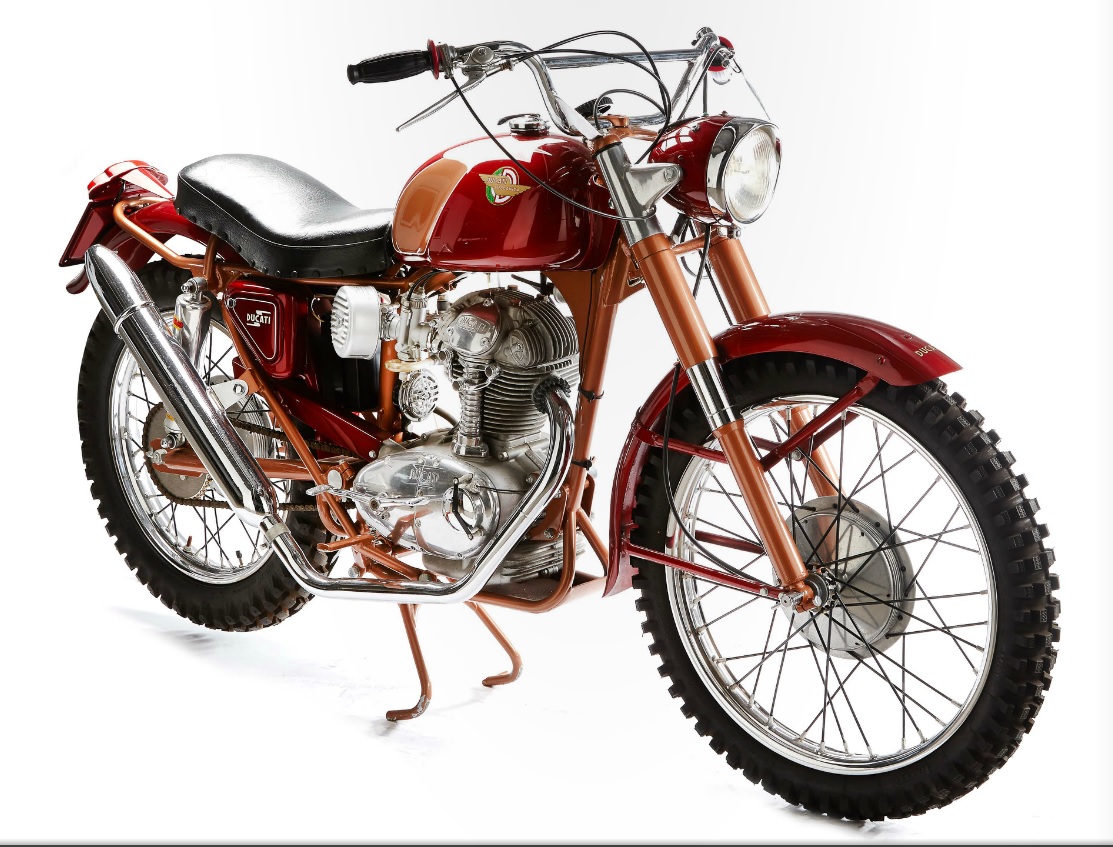
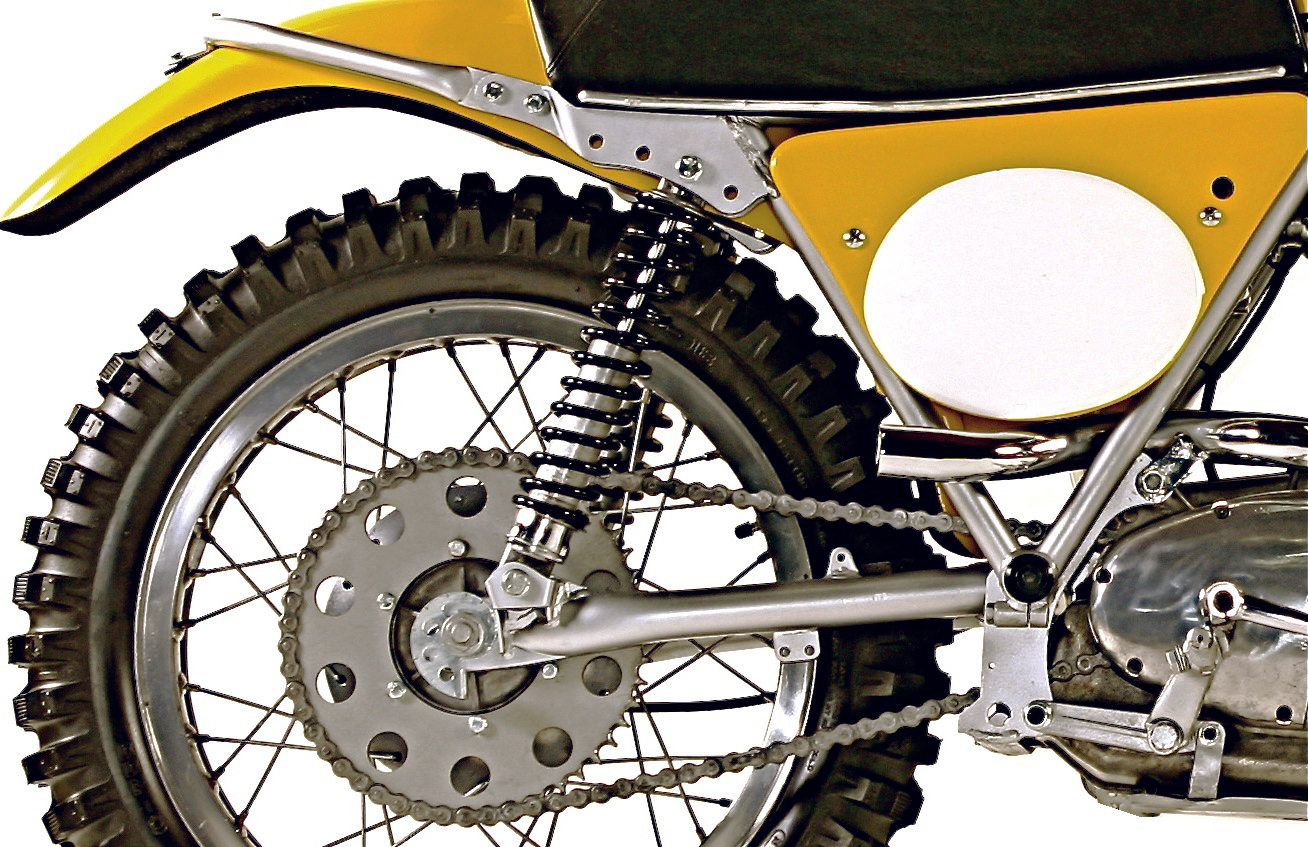
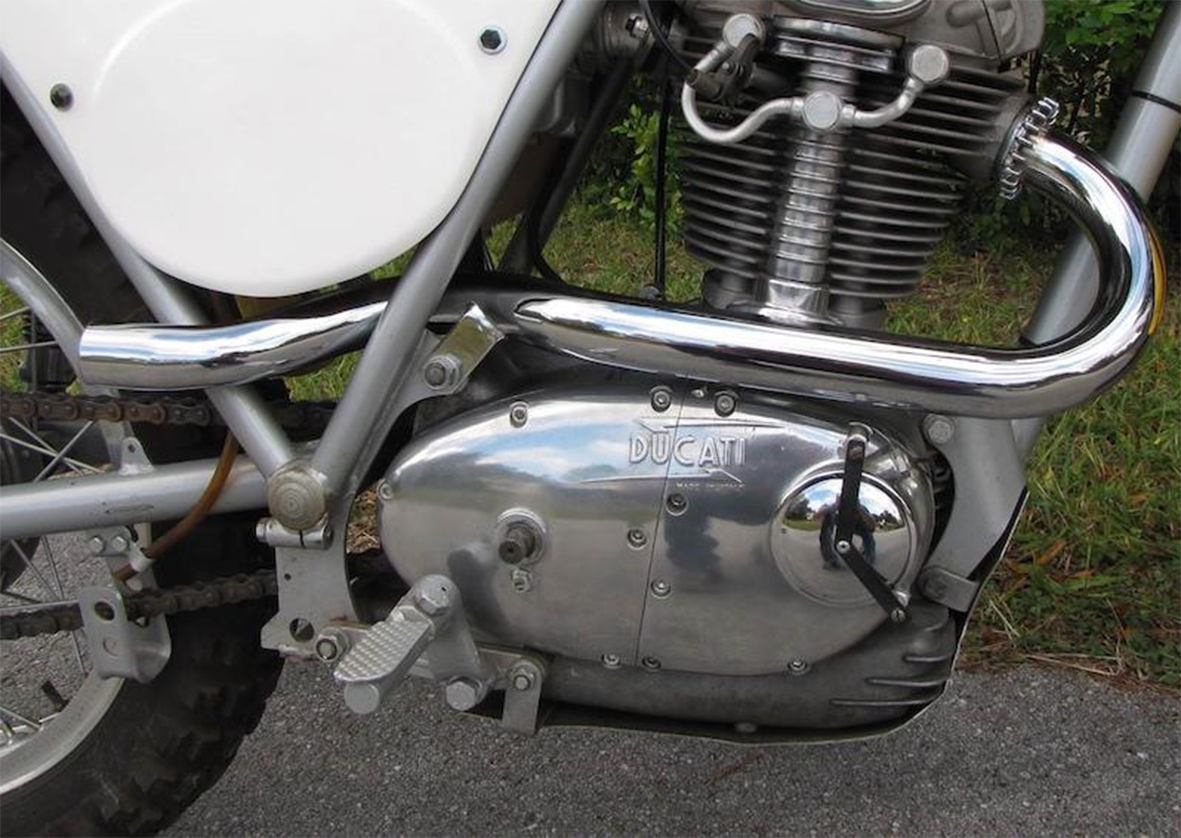
NOT PERFECT
Unfortunately, the rearward weight bias in the chassis (while great for wheelies) made handling a little sensitive when ridden hard. It was also thought that the suspension was under-dampened and the dry weight was too high at 128kg. The release date wasn’t ideal as the lightweight two-stroke revolution took hold and the R/T not as competitive.
4 STROKE BEVEL CHEQUERED FLAG
The 1972 450 Desmo R/T was updated but trended more toward street use. It included a high-capacity charge circuit, battery, full lighting, horn, tacho, speedo and even an optional ignition switch. Most of these only made it to the US market. The exhaust was now low slung and the silencer a Silentium full length, ‘half cut salami’ type. I imagine that Ducati decided to get some recompense for their investment by including domestic customers who wanted a more competent off-roader than the Scrambler.
No R/Ts were supposedly produced in 1973 although there is a photo in Phil Aynsley’s photo gallery of a 1973 model with black frame full exhaust and half chain guard which the owner insisted was completely as he removed it from the crate. Phil’s caption states that Australian R/T import numbers were 75 in 1971, 18 in 1972 and 40 in 1973. Ian Falloon quotes that production for 1974 included 35, 350R/Ts and 65, 450 R/Ts.
TWO-STROKE COMPY
2 stroke popularity saw the introduction of the Ducati 125 Regolarita in 1957 for the European off-road market. Italian 500 motocross champion Italo Forni was consulted for the competition-inspired 1977 125 Six Days. The frame was rejigged and strengthened and a high-level exhaust was used. Tank capacity was raised to 8 litres. The motor received a 34mm Bing carburettor and 14.5:1 compression (up from 10.5:1), increasing power to 25hp at 10,250rpm. 35mm Marzocchi ZTi magnesium forks helped reduce the bike’s dry weight to 97kg. Highly acclaimed, it was all a little too late with only 1,450 built from 1977 to 1979.
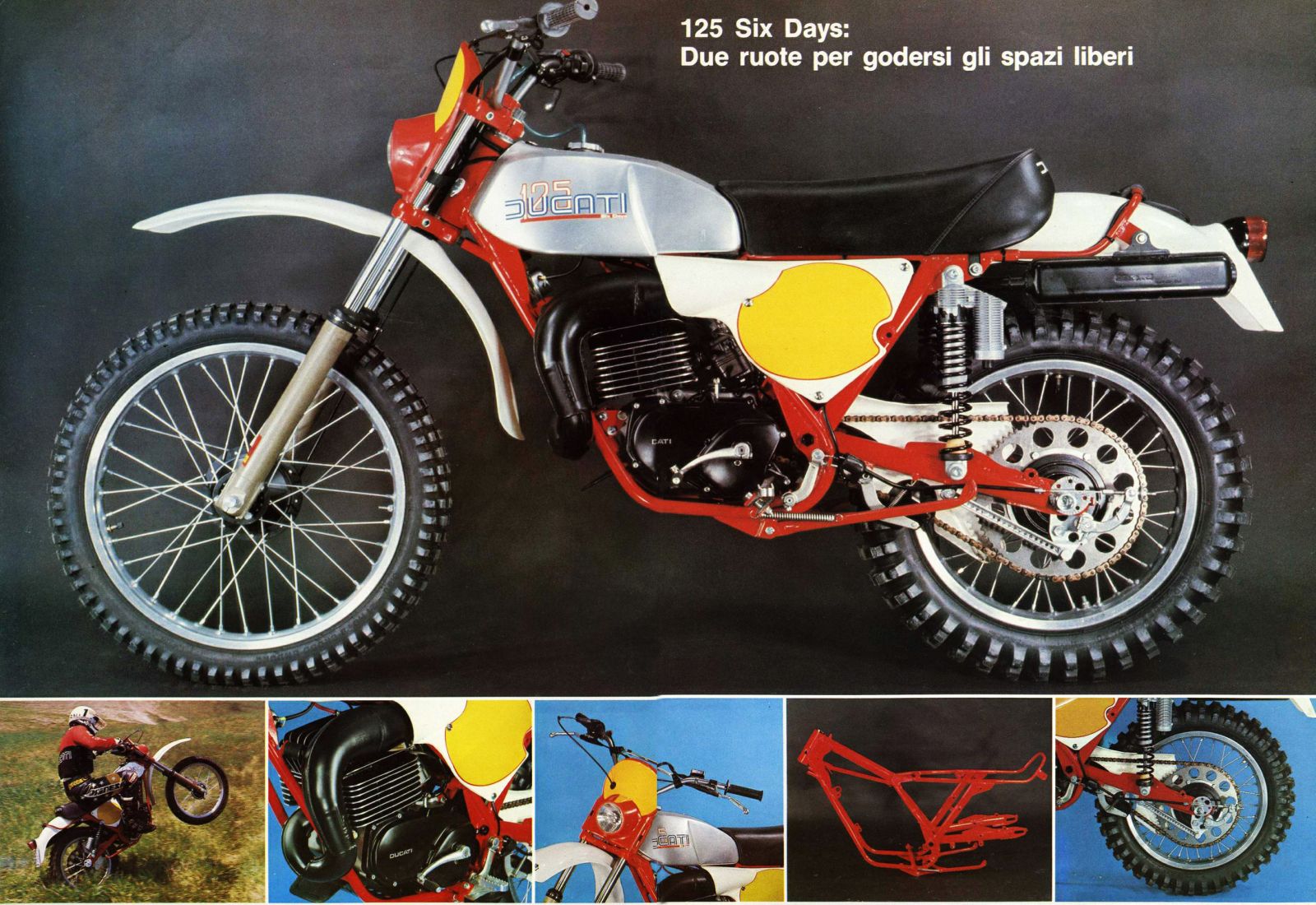
CAGIVA ELEFANT TWINS
The Castiglioni brothers (Cagiva) had been using some Ducati engines then in 1985 they bought the company. The Cagiva Elefant was their most famous off-roader, producing 350, 650, 750 and 900 versions between 1984 to 1996 (when they sold Ducati). Their most famous Elefant was the Primo Felotti enhanced 900, targeting the Paris-Dakar Rally. Christened the “Empress of Africa” it gave Edi Orioli two Dakar victories, in 1990 and in 1994 (entered as a privateer). Orioli’s Elefant 900 has an air/oil cooled 90° Ducati V-twin converted to a dry sump with a hand-built oil tank replacing the starter motor, so kick start only. It had a 59 litre fuel tank, a 1560mm wheelbase, a dry weight of 180kg and a top speed of 180km/h.
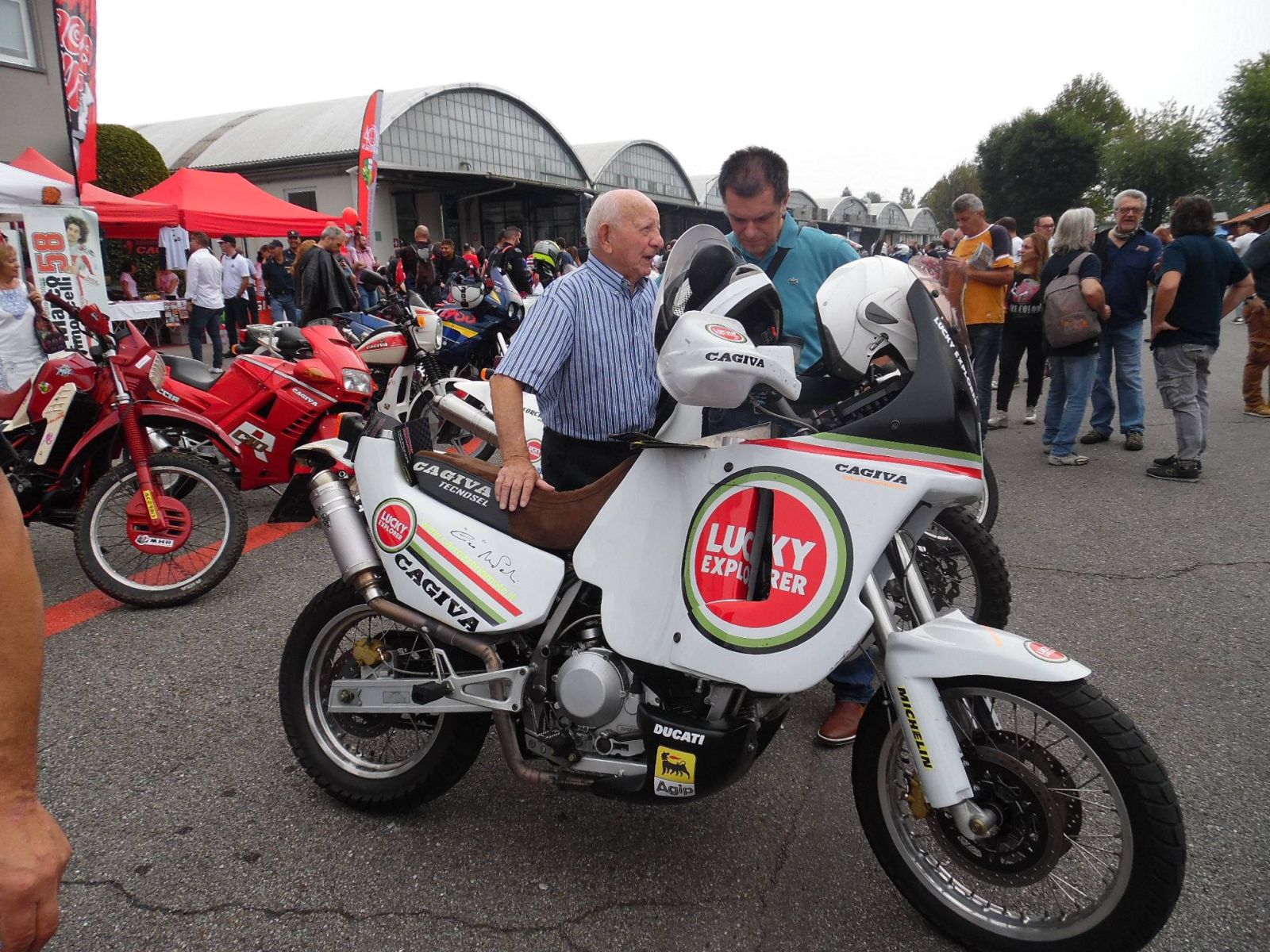
Front forks were conventional Marzocchis with a remote reservoir and an Öhlins controlled linkage rear-end delivering 290mm of suspension travel. The bash-plate gave good wrap-around protection and included a cut-out to allow engine cooling. The exhaust was ‘two into one’. A quick access paper element air filter was fitted on top of the frame backbone, surrounded by the tank and held in place by rubber bands. Cagiva produced around 1000 publicly available race bikes similar to Orioli’s machine. The differences included a fuel capacity reduction to 51 litres, dry weight increase to 189kg (225kg wet), wheelbase increase to 1640mm and an increased top speed to 190km/h. The high price (around 75% more than a comparable Honda XRV650 Africa Twin) kept sales low.
To reduce the price, later models had the seat height lowered 60mm, the EFI replaced by carburettors and the five-speed gearbox replaced by a six-speed. Twin discs replaced the single for the front wheel and Desmo service intervals increased from 5,000 to 10,000km. The Öhlins shock was replaced with a Sachs-Boge unit.
DUCATI TWINS
While offroad competition continues worldwide the Ducati brand is seldom seen competing. Motard racing however, which is a blend of road, dirt and motocross jumps and the Ducati Hypermotard 939 is considered very competitive.
Lindsay Hay’s 450 R/T Series 2
Doug Harbrow has ridden a few Moto Giro Australia events on his 1972 Ducati 450 Desmo R/T. His R/T is believed to have been a 1972 Australian delivered model with black frame, full electrics and street Silentium silencer. His path in life moved to guitars and the R/T was put up for sale. Lindsay Hay is a Ducati enthusiast and when I told him Doug was selling, he made contact instantly. It came with the earlier high-level snake exhaust and a mini-silencer to respect his urban neighbours. Since the purchase, Lindsay has tweaked a few things, like fitting a heat shield on the exhaust after burning a hole in his riding boots. Lindsay says it’s a joy to ride particularly through the twisty mountain roads where he lives.
Trevor Fryer’s 450 R/T
Trevor also enjoys his 1971 R/T with regular rides including the Moto Giro Australia (of which he is an organiser). In fact, there have been many R/Ts at the event over its 10-plus years. Trevor has also ridden it on several track days. The R/T’s lightness, agility, torque and wide bars make it superb to ride on both “Road and Track” which is as the maker intended.
AUTHOR: Gaven Dall’Osto

